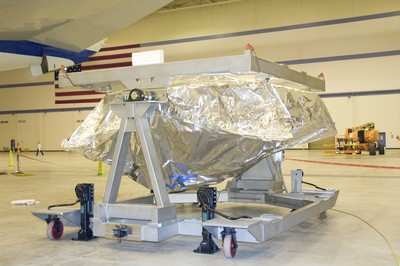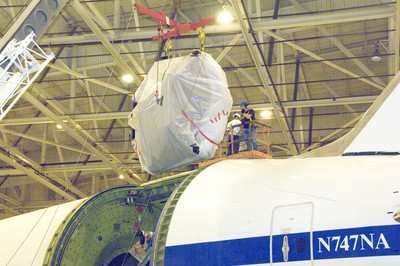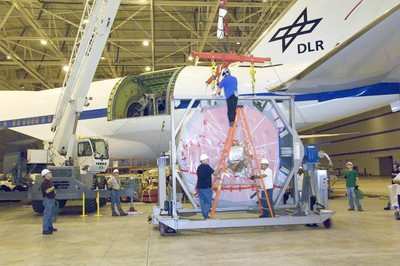German-Built Device Received New Reflective Coating
Engineers and technicians from NASA, the German Space Agency and
the Deutsches SOFIA Institut recently reinstalled the German-built
primary mirror assembly into NASA's Stratospheric Observatory for
Infrared Astronomy, or SOFIA, airborne observatory.

Technicians removed the glass mirror from the modified 747SP
observatory in April 2008 and transported it to NASA's Ames
Research Center in Moffett Field, CA, where it received its
reflective aluminum coating in a vacuum chamber in June 2008. The
coating, five one-millionths of an inch thick, will be reapplied as
necessary during the 20-year life of the program.
"We had completed system tests of our mirror coater but this is
the first time we've actually coated SOFIA's mirror. The team and
equipment performed flawlessly and the results are magnificent,"
says Ed Austin, SOFIA science project manager at Ames.
The mirror assembly was transported back to NASA's Dryden
Aircraft Operations Facility in Palmdale, CA mid-September, and
reinstalled October 8.
"The reinstallation of the mirror is a significant program
milestone on the path to science observations with the SOFIA
observatory in the summer of 2009," said Bob Meyer, SOFIA program
manager at NASA's Dryden Flight Research Center in Edwards, CA.

In coming months, both the telescope and the aircraft's
telescope cavity door system will be adjusted, leading to open-door
ground operational testing. These activities will be followed by
six to eight open-door flight tests next spring to study the
handling qualities of the aircraft as air flows over and into the
telescope cavity.
The upper rigid cavity door will be opened incrementally at
various altitudes to determine the aero-acoustic effects, or
buffeting, on the aircraft and telescope systems. NASA and
Deutsches SOFIA Institut, or DSI, engineers considered the
challenges of aero-acoustic effects on the telescope when designing
the cavity system, completing wind tunnel tests and computational
fluid dynamics analyses to minimize these effects.
SOFIA's state-of-the-art infrared telescope and some of the
observatory's scientific instruments will be tested on the ground
in the next few months in preparation for the first open-door test
flights.

The optical performance of the telescope system will be checked
using the High-speed Photometer for Occultations, or HIPO, science
instrument built for SOFIA at the Lowell Observatory in Flagstaff,
AZ. HIPO takes images of the sky rapidly at wavelengths the human
eye can see. Once HIPO has been used to check the basic
characteristics of the SOFIA observatory, the two infrared
instruments intended for the first scientific flights will be
mounted for more ground observation tests.
After these ground tests are complete, a short series of initial
astronomical science flights are planned. During the six scheduled
flights, the Faint Object Infrared Camera, or FORCAST, from Cornell
University, Ithaca, NY and the German Receiver for Astronomy at THz
Frequencies, or GREAT, from the Max Planck Institute for
Radioastronomy in Bonn, Germany, will conduct SOFIA's first science
observations.
SOFIA incorporates a 2.5-meter diameter infrared telescope in a
Boeing 747SP aircraft that will carry the telescope into the
stratosphere to conduct astronomical research. The observatory also
includes a ground-based science center.

SOFIA is a joint program between NASA and the German Space
Agency, Deutsches Zentrum fur Luft-und Raumfahrt or DLR. The SOFIA
program is currently managed at NASA Dryden and the aircraft is
based at the Dryden Aircraft Operations Facility. NASA Ames manages
the SOFIA science and mission operations in cooperation with the
University Space Research Association, or USRA, and the DSI.
 SpaceX to Launch Inversion RAY Reentry Vehicle in Fall
SpaceX to Launch Inversion RAY Reentry Vehicle in Fall Aero-News: Quote of the Day (04.23.24)
Aero-News: Quote of the Day (04.23.24) Aero-News: Quote of the Day (04.20.24)
Aero-News: Quote of the Day (04.20.24) ANN's Daily Aero-Linx (04.20.24)
ANN's Daily Aero-Linx (04.20.24) Aero-News: Quote of the Day (04.21.24)
Aero-News: Quote of the Day (04.21.24)






